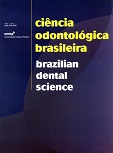Efeitos de 03 dietas alcoólicas na reparação óssea em tíbia de ratos
DOI:
https://doi.org/10.14295/bds.2009.v12i2.346Abstract
Os efeitos do uso abusivo e prolongado do álcool sobre vários tecidos, incluindo o ósseo, têm sido amplamente estudados. A quantidade de defeitos ósseos criados cirurgicamente e pelos vários tipos de acidentes tem aumentado e existe uma preocupação muito grande quanto ao reparo desses defeitos, associados ao alcoolismo. O objetivo desta pesquisa foi de observar histologicamente os efeitos de 03 dietas alcoólicas na reparação óssea e se o aumento da concentração do álcool também interfere neste fenômeno. Foram utilizados 64 ratos machos (Rattus norvegicus), divididos em 4 grupos de 16 animais cada, assim distribuídos: Grupo controle (C) – animais que não receberam álcool; Grupos Experimentais I, II e III (EI, EII e EIII, respectivamente) - animais que foram submetidos à alcoolização de 6%, 15% e 25% respectivamente, por um período de 90 dias. Após este período a tíbia esquerda de todos os animais foi submetida a uma cirurgia onde se realizou uma cavidade no sentido longitudinal. Quatro animais de cada grupo foram sacrificados em períodos de 10, 20, 40 e 60 dias contados a partir do dia da cirurgia experimental. As tíbias foram retiradas, processadas histologicamente e submetidas às colorações de HE e tricrômico de Masson. Os resultados mostraram que a neoformação óssea foi decrescente de acordo com o aumento da concentração alcoólica e pode-se concluir que as 03 dietas alcoólicas (6%, 15% e 25%) influenciam a neoformação óssea em todas as suas fases, retardando o processo de reparação óssea.
Downloads
Downloads
Published
How to Cite
Issue
Section
License
Brazilian Dental Science uses the Creative Commons (CC-BY 4.0) license, thus preserving the integrity of articles in an open access environment. The journal allows the author to retain publishing rights without restrictions.
=================




























